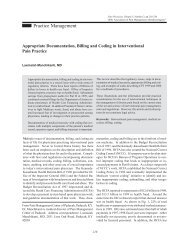ASIPP Practice Guidelines - Pain Physician
ASIPP Practice Guidelines - Pain Physician
ASIPP Practice Guidelines - Pain Physician
Create successful ePaper yourself
Turn your PDF publications into a flip-book with our unique Google optimized e-Paper software.
Manchikanti et al • <strong>ASIPP</strong> <strong>Practice</strong> <strong>Guidelines</strong><br />
34<br />
tion, marital status, children, habits, hobbies, and occupational<br />
history, whenever available.<br />
Physical Examination<br />
Physical examination in interventional pain medicine involves<br />
general, musculoskeletal, and neurological examination.<br />
Examination of other systems, specifically cardiovascular,<br />
lymphatic, skin, eyes, and cranial nerves is recommended<br />
based on the presenting symptomatology.<br />
Medical Decision Making<br />
Medical decision making refers to the complexity of establishing<br />
a diagnosis and/or selecting a management option<br />
as measured by three components, including;<br />
1. Diagnosis/management options with a number of<br />
possible diagnoses and/or the number of management<br />
options;<br />
2. Review of records/investigations, with number<br />
and/or complexity of medical records, diagnostic<br />
tests, and other information that must be obtained,<br />
reviewed, and analyzed; and ,<br />
3. Risk(s) of significant complications, morbidity<br />
and mortality, as well as comorbidities associated<br />
with the patient’s presenting problem(s), the diagnostic<br />
procedure(s), and/or the possible management<br />
options.<br />
Psychological evaluation, laboratory evaluation, imaging<br />
techniques, electromyography and nerve conduction and<br />
somatosensory evoked potentials are also an extension of<br />
evaluation process. It is beyond the scope of these guidelines<br />
to discuss these techniques of assessment.<br />
Appropriate history and physical examination with the assistance<br />
of other evaluations should direct a physician to<br />
formulate a provisional diagnosis. Features of somatic and<br />
radicular pain are outlined in Table 4. However, various<br />
pitfalls with conventional evaluation of low back pain are<br />
also illustrated in Table 5. A suggested algorithm for comprehensive<br />
evaluation and management of chronic pain is<br />
illustrated in Fig. 2. In summary, the following criteria<br />
should be considered carefully in performing interventional<br />
techniques:<br />
1. Complete initial evaluation, including history and<br />
physical examination.<br />
2. Physiological and functional assessment, as necessary<br />
and feasible.<br />
3. Definition of indications and medical necessity:<br />
• Suspected organic problem.<br />
• Nonresponsiveness to less invasive modalities<br />
of treatments except in acute<br />
situations such as acute disc herniation,<br />
herpes zoster and postherpetic neural-<br />
Table 5. Pitfalls with conventional evaluation of low back pain<br />
“Specific anatomic etiology is clearly and objectively identified in only 10% to 20%.”<br />
1. Radiographic “abnormalities” are frequently clinically irrelevant.<br />
2. True sciatica occurs in only 1% to 2% of the patients.<br />
3. No universal criteria are established for scoring the presence, absence, or importance of particular<br />
signs.<br />
4. Quantification of the degree of disability and the association to treatment outcomes is difficult.<br />
5. Interpretation of biomedical findings relies on “clinical judgments,” “physician’s experience,” and<br />
“quasi-standardized criteria.”<br />
6. Routine clinical assessment is frequently subjective and unreliable.<br />
7. Physical examination and diagnostic findings are subjective.<br />
8. The discriminative power of common objective signs has been questioned.<br />
9. Reliance on general “clinical impression” to detect gross psychological disturbances is “hopelessly<br />
inaccurate.”<br />
10. It is usually not possible to make a precise diagnosis or identify anatomic origin of the pain by routine<br />
clinical assessment.<br />
Adapted and modified from Manchikanti (41).<br />
<strong>Pain</strong> <strong>Physician</strong> Vol. 4, No. 1, 2001
















